Laminated Glass Market Size & Insights: 2031
The global laminated glass market size was valued at $19.3 billion in 2021, and is projected to reach $34.4 billion by 2031, growing at a CAGR of 6.1% from 2022 to 2031.
Report Key Highlighters:
- The laminated glass market is highly fragmented with several players such as AGC Inc., Asahi India Glass Limited., Central Glass Co., Ltd., CSG HOLDING CO.,LTD., FUSO, Guardian Industries, PRESS GLASS Holding SA, Saint-Gobain S.A., Sisecam and Xinyi Glass Holdings Limited.
- The study covers over 20 countries. The segment analysis of each country in terms of value and volume during the forecast period 2021-2031 is covered in the laminated glass market report.
- Over 5,000 product literatures, annual reports, and other similar materials from major industry participants were reviewed in order to have a deeper knowledge of the laminated glass market worldwide.
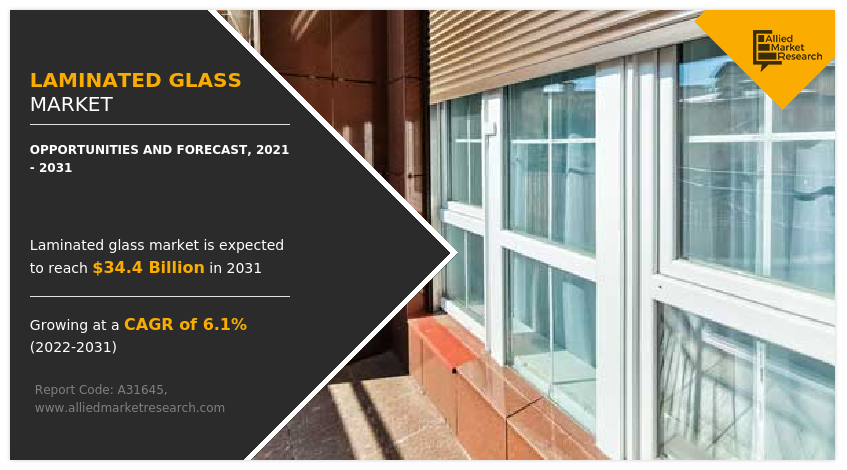
Introduction
Laminated glass is manufactured by pasting polyvinyl butyral (PVB) resin glue film between two or more pieces of glass sheet, then heating, pressing, and glueing them together to create flat or curved composite glass product. The glass sheet used to create laminated glass might be regular glass, float glass, tempered glass, colored glass, heat-absorbing glass, or heat-reflecting glass, among other types. There are 2, 3, 5, 7, or up to 9 layers.
Laminated glass is more impact resistant and has better transparency than regular sheet glass. Due to the adhesion of PVB glue film, even when glass breaks, its pieces remain bound to it and the surface of the broken glass is smooth and clean, thereby preventing penetration or falling of the shards and ensuring human safety. Laminated glass has a variety of qualities, including toughness, heat resistance, and moisture resistance.
Increasing demand from various end-use industries including construction, automobile, aviation, healthcare, and electronics is driving the laminated glass market growth
Laminated glass is used in car sunroofs and windshields, where it acts as a protection for the passengers in the event of a hard impact or outside pressure by forming a web-like pattern. Laminated glass is used in all of the vehicles produced by manufacturers including Tesla, Ferrari, and Volvo. High-end products like bullet-resistant glass and hurricane-resistant glass can be made using laminated glass due to its properties such as anti-shock, anti-break, and sound insulation.
Laminated safety glass has been used for exterior windows, doors, balustrades, and facades at The Vine Hotel in Mexico to ensure hurricane protection while preserving a contemporary, premium, clear appearance for the visitors. The construction industry makes substantial use of laminated glass. It is used in both residential and commercial construction due to its durability and strength. The safety feature associated with laminated glass is highly useful in locations requiring high security, such as banks, money exchange facilities, jewelry stores, museums, and art galleries. Moreover, laminated glass is used in the healthcare sector. Security and comfort for visitors to hospitals are requirements for healthcare facilities. Also, people need serenity in such an environment.
Security and privacy are first on the list of requirements, despite all the advancements that technology has made. Healthcare facilities frequently employ laminated glass solutions. It protects the hospital's property from both indoor and outdoor threats. The need for these solutions in healthcare facilities has been steadily increasing owing to the growth of the laminated glass industry.
The other factor boosting the growth of the laminated glass market is increasing infrastructural development across the globe. The foreign investments and urbanization triggered the infrastructural development. Good infrastructure accounts for the growth of economy of a nation. For instance, the Indian government pays a lot of emphasis on the infrastructure sector since it is essential to India's overall prosperity and helps to guarantee that world-class infrastructure is created in the country on time. The infrastructure sector includes the construction of highways, bridges, dams, power plants, and other types of infrastructure.
In an effort to give India its new identity, the Indian government is making a strong push with its policies to ensure that India has top-notch infrastructure. In India, for instance, significant industrial and infrastructure projects totaling about $1.3 trillion are currently being implemented. These infrastructure projects also include construction of various commercial and residential buildings, and others which make use of laminated glass due to its strength and shatterproof quality.
According to the Department for Promotion of Industry and Internal Trade (DPIIT), Foreign Direct Investment (FDI) totaled $26.17 billion and $26.30 billion between April 2000 and December 2021 in the construction development (townships, housing, built-up infrastructure, and construction development projects) and construction (infrastructure) activity sectors, respectively.
However, the high price of laminated glass and its initial installment are quite expensive which becomes a restraining factor in the global laminated glass market. More complicated machinery is required for the production process. Laminated glass requires more expensive materials to manufacture. The installation process is likewise more time- and labor-intensive. All of these problems result in increased laminated glass prices. This leads to the hampering of the laminated glass industry.
Employment is one factor that draws individuals from rural areas to urban places. The reduced employment opportunities in rural areas have contributed to this trend. In addition, urban areas are better able to address the needs of the population in terms of health and education, which encourages migration there. Hence, urbanization has been an opportunity to increase the growth of laminated glass market.
The migration of people to urban areas is great opportunity for the growth of the laminated glass market. More people are moving from rural to urban areas as the population of the world increases. By 2050, the United Nations projects that 70% of the world's population will reside in cities. Urbanization appeals to many rural residents due to the numerous chances it provides to improve their quality of life. Urbanization gives an opportunity for the expansion of the laminated glass market owing to these factors.
Segments Overview
The laminated glass market is divided on the basis of material type, application, end-use industry, and region. On the basis of material type, the market is divided into polyvinyl butyral, ethyl vinyl acetate, ionoplast polymer, aliphatic TPU and others (Sentryglas Plus (SGP)). Depending on the application, the market is classified into automobile windshields, bank security and ATM booths, jewelry shops, residential buildings and others (gas stations). On the basis of end-use industry, the laminated glass market is classified into building and construction, automotive, electronics, solar panels and others. Region wise, the laminated glass market share is analyzed across North America, Europe, Asia-Pacific and LAMEA.
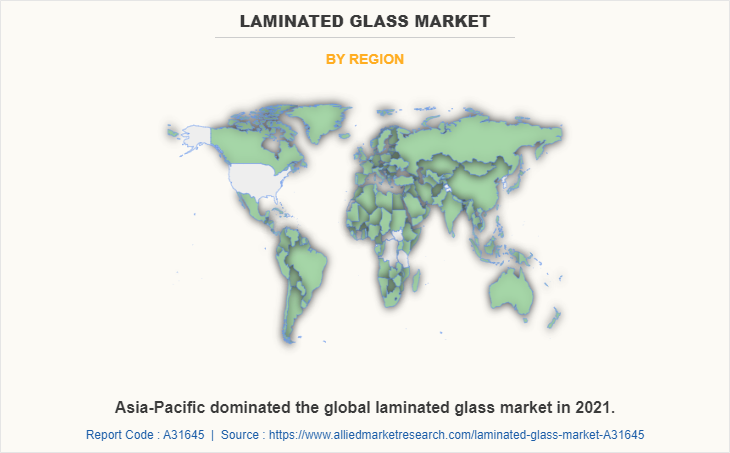
Asia-Pacific dominated the global laminated glass market in 2021. Laminated glass is widely used in solar panels. Over recent years, the demand for renewable energy has gained immense importance. Asia-Pacific region has a greater number of solar projects.
The increase in environmental concerns due to excessive usage of fossil fuel resulted in the usage of renewable energy. Currently, solar energy is utilized as it is available in abundance. The five largest solar projects in Asia-Pacific region are Golmud Solar CSP Power Plant, Mudigubba Solar Park, Xiangyang 1 GW Wind and Photovoltaic Power Plant, Xiangyang Vanadium Redox Flow Battery Energy Storage Plant and Ulanqab Green Power Station Demonstration Project PV Power Plant. Laminated glass is mainly employed in solar panels to protect the photoelectric semiconductor against environmental influences, such as moisture.
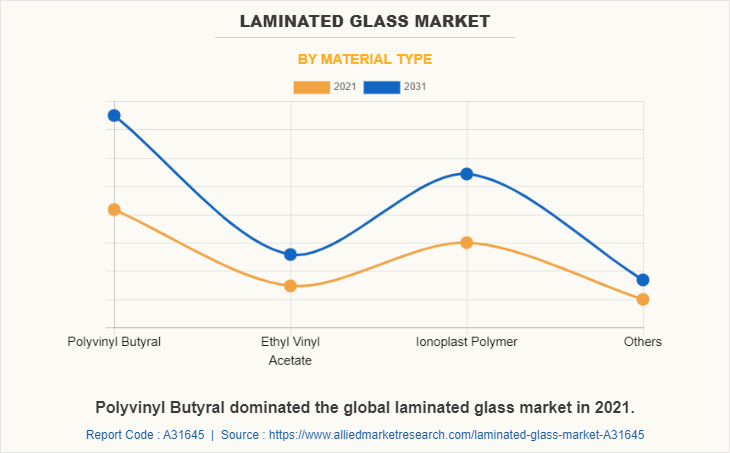
Polyvinyl Butyral dominated the global laminated glass market in 2021. Polyvinyl butyral (PVB) is a clear, strong, and flexible thermoplastic with exceptional optical clarity and good adherence to a wide range of surfaces. PVB resins are mainly used in the lamination of glasses due to its exceptional UV resistance, film-forming, adhesion, and flexibility qualities. In addition, PVB laminated glass offers a stronger acoustic barrier, decent impact resistance, and nearly 100% UV light absorption.
PVB is also crucial for safeguarding interiors against fading brought on by UV exposure. Therefore, manufacturers across the globe are producing PVB which is widely used as a raw material for the production of laminated glass. For instance, it is currently manufactured and sold by a number of companies including DuPont (Butacite, SentryGlas), Eastman Chemical Company (Butvar, Vanceva, Saflex), and Kuraray (Trosifol).
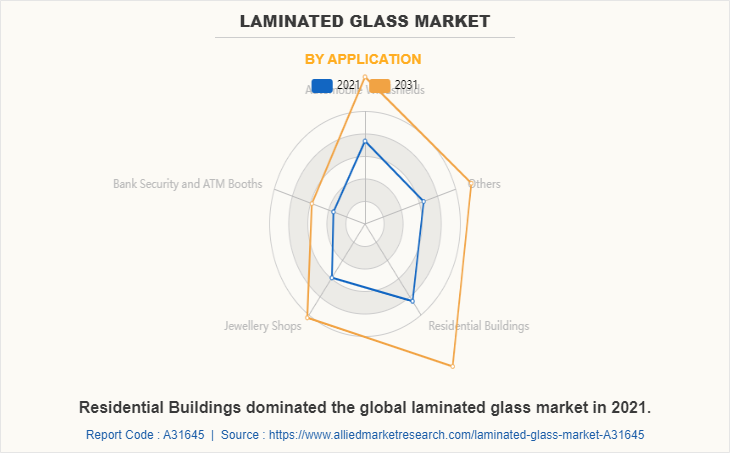
Residential Buildings dominated the global laminated glass market in 2021. Glass railings, floors, curtain walls, glass facades, and others are all made of laminated glass. It is excellent for overhead glazing in buildings since it does not shatter when damaged. Due to its exceptionally high strength value, laminated glass serves as a perfect alternative to glass.
Shatterproof glass is highly valued, particularly in the construction sector. It is therefore widely employed in residential constructions. Further, laminated glass is highly resistance to heat, chemical, and temperature. Also, it has good strength. Residential areas are prone to thief attacks, hence, for safety many constructors and builders make use of laminated glass.
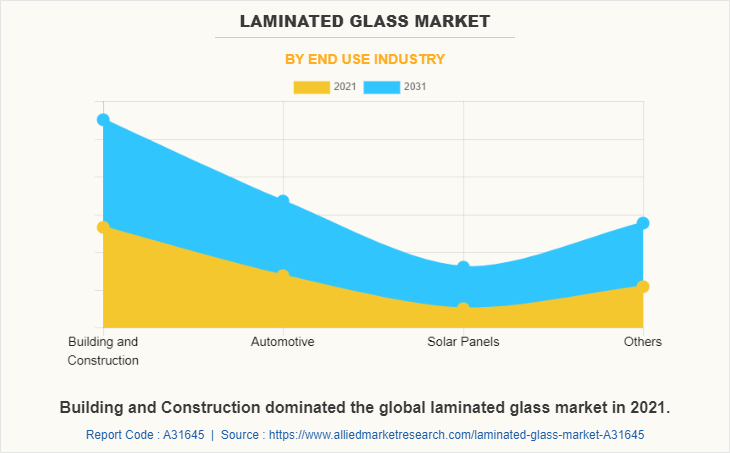
Building and Construction dominated the global laminated glass market in 2021. Glass is frequently used in construction due to its transparency, optical performance, and environmental resistance to wind, rain and temperature changes. Its intrinsic fragility makes it a poor choice for security applications as a fundamental material. Using laminated glass is generally the preferred way of overcoming these limitations.
Laminated glass has gained momentum owing to three main factors safety, more creative architecture designs and the increasing use of glass as a structural element. It is mainly used in commercial and residential spaces due to its strong nature and resistant to various factors like heat, temperature, chemicals and others. Laminated glass has good transparency, and its impact resistance is several times higher than that of ordinary sheet glass.
Competitive Analysis
The key players operating in the global laminated glass market report are AGC Inc., Asahi India Glass Limited., Central Glass Co., Ltd., CSG HOLDING CO.,LTD., FUSO, Guardian Industries, PRESS GLASS Holding SA, Saint-Gobain S.A., Sisecam and Xinyi Glass Holdings Limited.
Key Benefits For Stakeholders
- This report provides a quantitative analysis of the market segments, current trends, estimations, and dynamics of the laminated glass market analysis from 2021 to 2031 to identify the prevailing laminated glass market opportunities.
- The market research is offered along with information related to key drivers, restraints, and opportunities.
- Porter's five forces analysis highlights the potency of buyers and suppliers to enable stakeholders make profit-oriented business decisions and strengthen their supplier-buyer network.
- In-depth analysis of the laminated glass market segmentation assists to determine the prevailing market opportunities.
- Major countries in each region are mapped according to their revenue contribution to the global market.
- Market player positioning facilitates benchmarking and provides a clear understanding of the present position of the market players.
- The report includes the analysis of the regional as well as global laminated glass market trends, key players, market segments, application areas, and market growth strategies.
Laminated Glass Market Report Highlights
| Aspects | Details |
| Market Size By 2031 | USD 34.4 billion |
| Growth Rate | CAGR of 6.1% |
| Forecast period | 2021 - 2031 |
| Report Pages | 300 |
| By Material Type |
|
| By Application |
|
| By End Use Industry |
|
| By Region |
|
| Key Market Players | CSG HOLDING CO.,LTD., AGC INC., Sisecam, Asahi India Glass Limited., Xinyi Glass Holdings Limited., Guardian Industries, Saint-Gobain S.A., PRESS GLASS Holding SA, FUSO, Central Glass Co., Ltd. |
Analyst Review
According to the opinions of various CXOs of leading companies, the rise in building industry around the world is expected to fuel the growth in the laminated glass market during the forecast period. The primary factor propelling the global laminated glass market is the rise in automobile safety norms. In addition, the market for laminated glass is anticipated to benefit from investments in infrastructure projects in the Middle East and Africa, as well as Asia-Pacific, during the anticipated period. The market for laminated glass in Asia-Pacific is anticipated to increase as a result of increased investments by several car manufacturers.
The global laminated glass market is witnessing an increase in utilization due to growing public awareness of the benefits of using safety glass in the building and construction industry. Laminated glasses offer a variety of advantages, including safety, security, increased durability, soundproofing, and others. Numerous end-user industries, including telecom, healthcare, aerospace, and electronics, are investing in laminated glasses because of the increased safety and security they provide. Laminated glasses are widely installed due to their strength, impact resistance, sound reduction, cyclone and earthquake resistance, bullet resistance, and other qualities. The demand for laminated glass in the building sector is on an increase. The need for laminated glasses has also increased in the automobile sector.
The global laminated glass market was valued at $19.3 billion in 2021, and is projected to reach $34.4 billion by 2031, growing at a CAGR of 6.1% from 2022 to 2031.
The laminated glass market is driven by the high demand from various end-use industries such as construction, automobile, aviation, healthcare, electronics and others.
Residential buildings is the leading application of Laminated Glass Market.
Asia-Pacific is the largest regional market for Laminated Glass.
The key players operating in the global laminated glass market are AGC Inc., Asahi India Glass Limited., Central Glass Co., Ltd., CSG HOLDING CO.,LTD., FUSO, Guardian Industries, PRESS GLASS Holding SA, Saint-Gobain S.A., Sisecam and Xinyi Glass Holdings Limited.
Loading Table Of Content...



